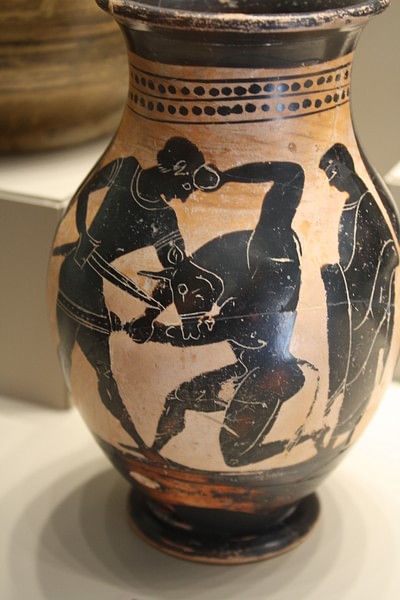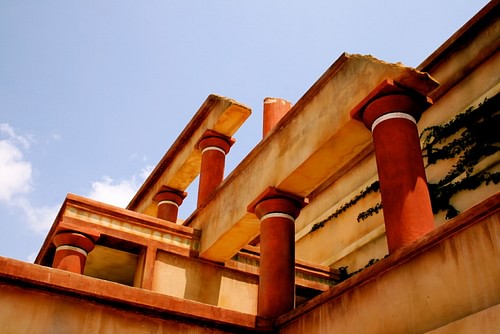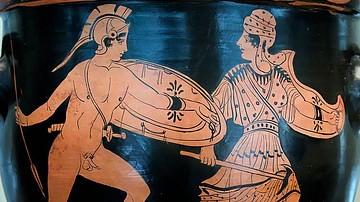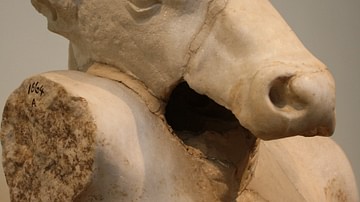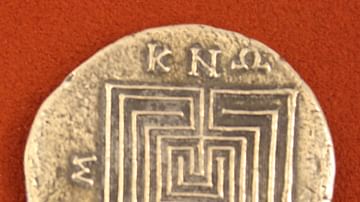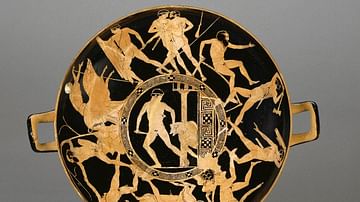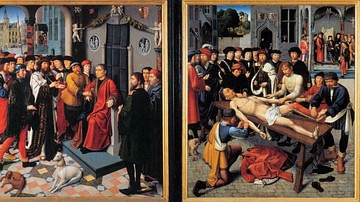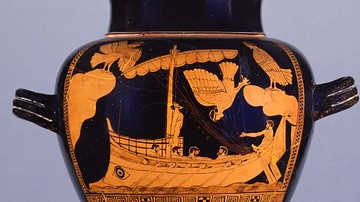Until Sir Arthur Evans unearthed the palace of Knossos, the half-man-half bull killed by Theseus was considered just a popular legend; archaeology changed that perception.
King Minos, of Crete, fought hard with his brother to ascend the throne and, having won the kingship and exiled his brother, prayed to the god of the sea, Poseidon, for a snow white bull as a sign of the god's approval. Minos was supposed to sacrifice the bull when it appeared but it was so beautiful he kept it instead. Angered at Minos' ingratitude and selfishness, Poseidon caused Minos' wife, Pasiphae, to fall in love with the bull so deeply that she mated with the animal; the offspring was a male with the head and tail of a bull. The Minotaur was at first cared for by Pasiphae but grew violent as it grew older and Minos had the architect Daedalus design an intricate labyrinthin the palace in which the creature was kept.
The city of Athens, according to one version of the story, was responsible for the death of King Minos' son, Androgeus, and had to pay a tribute to the King of Crete of seven of the best and most noble youths and seven of the finest and most virtuous maidens every year (according to other versions it was every nine years) who would be sent to Crete aboard a ship with black sails, cast into the labyrinth deep within the palace of Minos, and be eaten by the Minotaur.
Theseus, son of King of Aegeus of Athens, volunteered to end the tribute by taking his place among the youths and killing the Minotaur. With the help of King Minos' daughter, Ariadne, Theseus succeeded in slaying the monster and fled with Ariadne back toward Athens, leaving Ariadne behind on the island of Naxos (whether by accident or on purpose depends on which version of the story one reads). Theseus was supposed to change the black sails of the ship to white so that King Aegeus would know his son lived and had conquered the Minotaur. Theseus forgot, however, and his father, seeing the ship with the black sails, hurled himself off a cliff into the sea in grief and was drowned (the sea became known as the Aegean, after him).
The palace of King Minos, Knossos (also spelled Cnossos or Cnossus) was discovered by Sir Arthur Evans in 1894 and excavation began at the site in March of 1900. Whether Minos was the name of an individual king or a title like `Pharaoh' we do not know but Herodotus mentions Minos in his Histories, "Minos of Cnossus" as having ruled the sea and Herodotus also mentions a detail found in the myth of the Minotaur, "Sarpedon and Minos [of Crete] fought for the throne and the victorious Minos expelled Sarpedon". Evans knew the stories of Minos and of Knossos, and upon finding murals of bull jumping youths in the palace, posited that perhaps Knossos was the labyrinth from the story of Theseus and the Minotaur. The archeologist Michailidou writes, "Behind the pre-Hellenic word labyrinthos - which is etymologically allied to the word labrys (double axe) - is perhaps the very palace of Knossos, the ruins of which reveal the labyrinthine complexity of its structure" and, further, "It is amazing how long one can spend wandering in and out of these rooms, going up and down stairs and, frequently, much to one's surprise, finding oneself back in the same room having come by a different route". Durant also notes, "The sprawling palace in all likelihood is the famous Labyrinth, or sanctuary of the Double Ax (labrys), attributed by the ancients to Daedalus".
The Double Axe symbol was the sign of the Minoan goddess and was found abundantly throughout Knossos, especially in the Hall of the Double Axe. It was Evans who gave the name Minoan to the culture he discovered at Knossos (after King Minos, of course) and Minoan bull jumping - a sport engaged in by both men and women - was widely known even to the ancients (Plato makes mention of weaponless bull hunting in his Critias in 119 CE, speaking of Atlantis, which is most likely a fictionalized version of Crete). The story of the Minotaur, a half human-half bull, could have originated from the bull jumpers of Knossos (who, in their acrobatic leap over the bull, became `one' with it momentarily before vaulting over the horns) in the same way the story of the labyrinth can be seen as originating from the complex structure of Knossos itself, as Evans, and others, have suggested. Perhaps the myth of Prince Theseus and the Minotaur in the labyrinth has more truth than `myth' to it after all.
A version of this article was first published on the site Suite 101 in January 2009.
